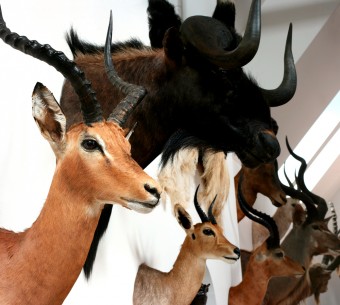Last Updated on March 8, 2024
By Patrick Galvan, Storage.com
A taxidermy collection is among your most prized possessions as a hunter. All of those hours spent on preparation and patient waiting mean you can show off your kills to family, friends, and fellow hunters.
It’s not often that you’ll transport these specimens, but if you’re moving or renovating your home—or your spouse says there are too many dead animals in the house—you may need to find a safe place to store your collection. Instead of an attic, basement, or garage, store your taxidermy collection in self storage.
Proper Ways to Handle Your Taxidermy Collection
Before you even consider storage, your taxidermy collection needs to be properly insulated. Outdoor storage isn’t an option because your trophies will be exposed to direct sunlight (which will cause fading) and carrion-eating parasites, such as insects. Don’t rush with indoor storage either. What good are adequate storage conditions if your trophies become scratched or torn due to poor packaging?
 “The best way to prevent problems with pests, dust, and sunlight is to seal the collection in wooden crates,” says Pixie Hicks, owner of Hicks Taxidermy in Northport, Ala. “Many times, your local taxidermist is happy to give these to you. You simply attach your mounts to the inside [of the crate] using wood screws.”
“The best way to prevent problems with pests, dust, and sunlight is to seal the collection in wooden crates,” says Pixie Hicks, owner of Hicks Taxidermy in Northport, Ala. “Many times, your local taxidermist is happy to give these to you. You simply attach your mounts to the inside [of the crate] using wood screws.”
In loading your trophies, you might need a second person to hold the plaque of each individual specimen against the crate interior while you set the screws. If you store multiple trophies in one crate, you’ll need to figure out how to fit them all so they don’t end up pressed together or stacked on each other. Constant abrasion could leave marks in the hides.
Do you need to wear gloves when handling your collection? Not necessarily. “Present-day taxidermy specimens are preserved using a dry preservative or tanning process,” Hicks explains. “If simply hanging them for your enjoyment were dangerous, we wouldn’t have museums.” However, she says some mounts can contain toxic materials, like arsenic and/or mercury, in which case you’d want to wear gloves.
Protecting Your Taxidermy Collection from Pests
Once you’ve loaded your mounts, the next step is preserving them in storage. One of the values of keeping your trophies in a self storage unit is that you can access them on a regular basis for cleaning.
According to Hicks, pests are a dominant threat. “There’s nothing worse than [collecting] your stored trophies and finding that an invasion of roaches, moths, rats, or mice have intruded and caused damage.”
“There’s nothing worse than [collecting] your stored trophies and finding that an invasion of roaches, moths, rats, or mice have intruded and caused damage.”
Pixie Hicks, owner of Hicks Taxidermy
To protect your taxidermy collection from an infestation, Hicks recommends placing poison pellets, No Pest Strips, and silica gel packets inside the crate(s) just in case rodents manage to chew their way through the crate walls. Coat the seams of the crate with a silicon sealant for extra insulation.
Why Climate Control Is Important When Storing Taxidermy
When storing your taxidermy animals, it’s important to maintain consistent temperature and humidity levels inside the storage unit. “With wider temperature fluctuations, skins will contract and expand, eventually causing hides to crack,” Hicks explains. To prevent this, you’ll need a self storage unit equipped with climate control. This amenity acts as a heater, air conditioner, humidifier, and dehumidifier in your unit to control temperature and humidity levels.
“Climate-controlled storage is the only way to go with ensuring safe preservation of your valued mounts,” Hicks says. “[Between] 60-85°F is the recommended tolerance. Ask about humidity control and look for units [that] do not allow humidity to exceed 60%.”
Daniel Wetzel of Wetzel & Sons Moving and Storage in Pacoima, Calif., agrees about controlling humidity. “Low relative humidity is the potential cause of extreme dryness, shrinkage, and cracking. High relative humidity can cause warping and swelling, so they’re important things to take into consideration when storing delicate items.”
Other Storage Features for Taxidermy Storage
In addition to climate control, there are other features you should look for in a storage facility when storing your taxidermy collection. Hunting trophies are one-of-a-kind items that cannot be replaced, so it would be a terrible thing to have them stolen. For this reason, your facility should have good security features, such as gated access, video surveillance, alarmed units, or on-site management. Any one (or combination) of these security features can help protect your items in self storage.
“Vaulted storage is perfect for storing a customer’s prized possessions.”
Daniel Wetzel of Wetzel & Sons Moving and Storage
Not all facilities feature vaulted storage, but if you can find one that does, you’ll have an extra level of protection for your trophies. “Vaulted storage is perfect for storing a customer’s prized possessions,” says Wetzel. “Each item is properly prepared and carefully packed to ensure optimum storage conditions. Once properly prepared for storage, they’re placed on storage racks where they’re kept safe and dust-free.”
A hunting trophy is neither inexpensive nor is it easy to obtain, so you’ll want to ensure the best possible protection when storing your collection. If the storage facility you select can provide climate control and adequate security, your specimens should remain in good condition for the next time they go on display.




